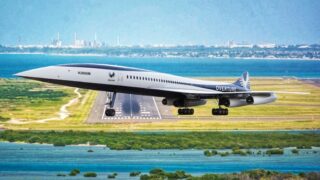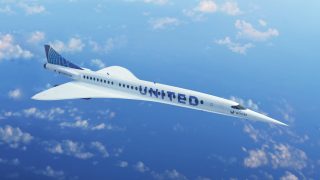We recently wrote about the upcoming Boom supersonic airliner, which plans to be in the skies heading to Hawaii in the next seven years. But will it happen? It depends on who you ask.
Hawaii had its share of supersonic flights, dating back to the 1980s. But could they become a regular part of Hawaii travel? American Airlines and United Airlines are betting they can, while Delta, at least for now, is heading in another direction.
Boom, the United Airlines and American Airlines Supersonic Overture plane manufacturer, says they have the knowledge needed to restart trans-oceanic supersonic travel some two decades after it stopped. Do you even remember that there were even some Concorde SST flights to Hawaii?
Boom CEO Blake Scholl believes in his airplane and the demand for supersonic travel, with Hawaii conceivably accessible within just a couple of hours from the west coast. That comes despite significant skepticism others have raised.
Boom says, “There’s a need for hundreds, if not thousands, of these airplanes.”
The company has determined that there are some 600 routes globally where their Overture SST could fly while at the same time reducing the flying time by about one-half. That’s interesting to consider, given that Concorde SST flew few routes, and only 20 planes were built, with 14 delivered to airlines.
Boom is an American (Colorado-based) company seeking to launch its 1,300 MPH, 65-88-passenger supersonic plane.
SST doubts turn primarily on the engines and manufacturer.
Despite contracts with two of the world’s largest airlines, American and United, an engine manufacturer and type have not been announced, which has resulted in increasing doubt about the viability of Overture SST.
Boom said they are within months of an “exciting engine announcement.”
He also told Financial Times, “It’s not just about the engine technology. It’s about some breakthroughs in the sustainability and breakthroughs in the business model that will lead to better economics.”
The engine options include turbojets and turbofans. The former works by propulsion due to its exhaust gas, whereas the latter creates power by the air accelerated by its fan blades. Experts say that turbofans are more efficient than turbojets while having issues with their added size. Some other options include afterburners, such as are seen on military planes. It’s complicated, that’s for sure, and it will be exciting to see what Boom will announce.
Fuel type and consumption are other big concerns.
The fuel consumption for SST travel is far greater than for current sub-sonic jets. And there isn’t enough sustainable fuel required to power these planes. One analyst estimated that the fuel bill per passenger is 20 times that of sub-sonic planes.
The plane can nimbly reach the west coast with its 4,250 nautical mile range.
Due to sonic booms, it isn’t likely to ever reach beyond the west coast or would need to do so at less than supersonic speed. Boom is planned as a “sustainable” aircraft, which will “run on 100 percent sustainable aviation fuel (SAF).”
There are already 130 Overture jets on order.
In the most recent addition, American Airlines just paid a deposit on twenty supersonic airplanes, with an option for up to 40 more. That followed Japan Airlines’ original order for twenty planes and United’s recent order for up to fifty Overture SSTs. These major airline orders give much-needed credibility to Boom’s planes.
Some aviation analysts say that it will still never come to pass.
Kevin Michaels, an aerospace consultant for 35 years, said recently that Overture SST “is a paper airplane right now… [with] so many issues for Boom to overcome. I don’t expect to see it.”
Boom is still seeking billions of dollars to complete the plane but has raised less than $1 billion.
All eyes are on Boom’s XB-1 for now.
The industry is watching the upcoming flight of the small Boom demonstrator, which is due to take to the air in the next few months.
1. American says Boom SST is important to them.
“Looking to the future, supersonic travel will be an important part of our ability to deliver for our customers,” according to Derek Kerr, CFO. “We are excited about how Boom will shape the future of travel both for our company and our customers.”
2. Delta says not so fast.
“Candidly, I still have many more questions than answers,” said Delta CEO Ed Bastian. “Until we’re confident that we can actually generate a reliable return from the aircraft, that’s not where we’re investing.”
3. United says they’re enticed.
United’s Scott Kirby said, “Boom’s vision for the future of commercial aviation, combined with the industry’s most robust route network in the world, will give business and leisure travelers access to a stellar flight experience.”
Possible Overture Hawaii routes and prices.
As we said previously, “West coast markets to Honolulu and Maui include the Bay Area (San Francisco or Oakland) and Los Angeles (2.25 hours). International destinations might include Sydney, Australia (4 hours) and Tokyo, Japan (3 hours). Domestic flights other than overwater aren’t going to happen due to the sonic boom, which, while said to be less on Boom, will still be an issue. As for ticket prices, we can’t say what fares could be to fly on the Overture jets, but we’d expect them to be somewhat higher than the typical first-class fares that Hawaii visitors now pay.”
First Boom Overture aircraft set for completion in 3 years.
Subsonic flight testing will be at the Piedmont Triad International Airport in North Carolina.
Past supersonic travel to Hawaii.
In 1987, a service was planned to bring SST travel to Hawaii. The route was from Oakland to Honolulu within just 2 hours of flying time. After that, five Air France Concorde charter flights arrived in Hawaii at 1,400 miles per hour. Other charters landed at Kona on at least six different occasions.
Get Breaking Hawaii Travel News






The Boom SST would be an excellent opportunity to travel in half of the time. The cost may be prohibitive to many typical flyers but for those who can afford it it shall be their go to choice. Imagine a JFK To the Philippines in less than 10 hours! That could make far away destinations feel like they’re less than half a day away. I hope that they succeed beyond our doubts and imagination, that would be great!
The time has come !
I’m in the not going to happen to camp. The time frame just doesn’t add up. Southwest is putting sustainable aviation fuel into their Oakland facility.
Aloha
Two words…”Super Ferry”
Two more…”Mauna Kea”
Does matter what mainanders want…no way locals will allow.
how many people are going to pay the extra astronomical cost for a ticket just to save a couple of hours flying time. there will probanly be a lot of one time users just to say they had done it just like on the Concorde. I like to say i did it.
There probably is a niche market for these planes on Hawaii routes. Your recent report that hotel rooms are averaging $1,600+ has me believing that visitors will pay any price to go to Hawaii.
With fuel consumption 20 times that of standard jets, BOOM could be quite an attraction tonthose who can afford Hawaii at all.
It won’t happen anytime soon. It has no engines and nobody wants to spend the r&d to make them. It will probably evolve to be a private jet at some point.